| Wildlife Conservation in Botswana |
|
[Last updated: 01-Aug-2022]
| Start | | | Week 1 | | | Week 2 | | | Week 3 | | | Week 4 | | | Week 5 | | | Week 6 |
The temperature was 20°C at 09:00 - cold! The wind was still blowing and the sky was totally covered in cloud. However, by about 14:00, the majority of the cloud had disappeared, but the sky was very hazy.
Being the weekend, the volunteers have to prepare the lunch and dinner.
Today, it was down to Esteban and myself. The menu for today's lunch was
American Pancakes. I offered to make the batter. However, when it came to
cooking the pancakes, it was obvious that something was lost in
translation! I had made a 'thin' batter (for crêpes or Yorkshire
Pudding), not a 'thick' (or stiff) batter for those thick, spongy American
flapjacks. Once we had fully understood the situation, it was quickly
resolved by adding more flour, sugar and yeast! [To be honest, I don't
think anyone noticed the difference, once lashings of Golden Syrup and/or
Peanut Butter had been spread over the cooked result! ;-)]
Monday, 12-Sep-2016
Today's two projects: Spoor (Footprint) Identification and a Baobab Tree Census.
With Dicks as our driver, we set off just after 07:00. In chronological and numerical order along the route (view in Google Earth), we saw footprints of the following species; multiple sightings of the same footprint have not been included.
Note: These seven animal links have been taken from Wikipedia's List of Mammals of South Africa.
After looking at several footprints, we climbed a nearby koppie, from where we had a wonderful view of the bush (Photo BW-034 and Photo BW-035). The location of the koppie (at GPS: S22°22'37.74" E28°54'24.88") is included in the Google Earth view. As can be seen in the photos, the weather had returned to 'normal' (whatever 'normal' is); i.e., a clear sky. Fortunately, the temperature had dropped from in the 30s Celcius, down to the upper 20s Celcius. From the top of the koppies, herds of animals could be seen and watched (when visible) in safety!
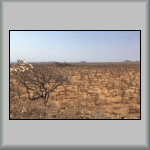 Photo BW-034 |
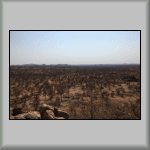 Photo BW-035 |
At 14:30, after lunch, and with Jo as our guide, we left the Motswiri camp to undertake a Baobab Tree census on the Sukses property. We started at GPS: S22°22'3.66" E28°54'25.56" and finished (after measuring three trees) at the waterhole at GPS: S22°19'33.60" E28°50'49.30". The required tree measurements were: the tree's girth at its base, the girth at 1.3 metres above the ground level, the height of the tree and the height of the lowest living branch. These last two measurements are taken using a simple theodolite-like meter, at a distance of 20 metres from the base of the tree.
We arrived back at camp to be greeted by, and introduced to, Tyler, a new volunteer, from the U.S.
Today's two projects: Road Clearing and Repair, and a Mammal Census.
For the road clearing activity, we completed what was started last Thursday afternoon, by removing parts of the steep river banks (so that vehicles could traverse the river), as well as rocks and tree roots and branches between the river and the tarmac road (at GPS: S22°16'18.00" E28°51'36.63"). Driven by Jo and supervised by Dicks, the following video shows the first crossing of the (then) dried-up river bed by one of the Land Cruisers.

First Crossing of River
[3 minutes, 00 seconds]
At lunchtime, the sky was cloudless, but the wind had strengthened.
Dicks drove us for the afternoon's mammal census. The following list shows (in chronological order) the animals we saw and recorded along our route (which can be viewed in Google Earth). As with the footprints, multiple sightings of the same mammal have not been included.
Notes:
Today's two projects: Anti-Poaching Patrol, and Pole and Wire Removal.
As usual, we left Motswiri at 07:00 and headed to the anti-poaching patrol starting point; just a few metres from one of the roads to Mathathane (GPS: S22°15'55.54" E28°48'50.57"). As can be seen in Photo BW-036, we were greeted by a heavy and overcast sky. Nearby, a group of (Daniel's) men were demolishing an old concrete water container (with sledge hammers, etc.) that had been built some decades ago. With the help of our guides Jo and Daniel (Photo BW-037), we found and retrieved 12 wire snares and a separate length of wire! The two guides are more acustomed to spotting the wire snares than we (volunteers) were! It was great to think that we probably saved the lives of at least 12 wild animals!!
At lunchtime, more cloud had come in, blown by a very strong wind. It was a very cold day (even at 18°C)! Even one or two of the resident squirrels came in out of the cold (Photo BW-038)!
With lunch finished, and for the Pole and Wire Removal activity, someone had already thought about the possible amount of 'rubbish' we were expected to bring back to camp. So, for the afternoon's activity, we left for the Mopane Reserve in two trucks; one for the workers and one to carry what we might find! By the way, a few minutes after leaving the camp, we came across a small herd of elephants (Photo BW-039). Moving forward a few metres, I was able to get a closer view of them (Photo BW-040).
There was also a pair of giraffes near the waterhole (Photo BW-041 and Photo BW-042).
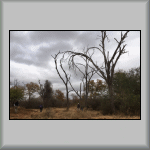 Photo BW-036 |
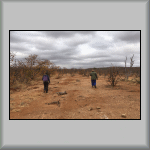 Photo BW-037 |
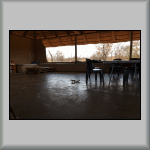 Photo BW-038 |
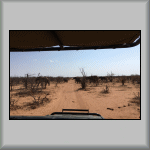 Photo BW-039 |
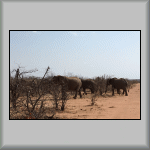 Photo BW-040 |
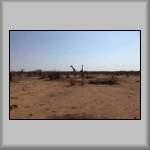 Photo BW-041 |
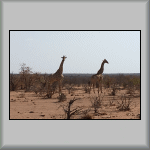 Photo BW-042 |
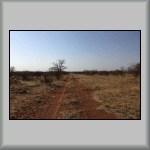 Photo BW-043 |
The cut lines go on for kilometres, as can be seen in Photo BW-043. Once we had reached the designated area along the chosen cut line, it was obvious that the second truck was needed!
We started retrieving wire by the metre; there was a lot of it! Also, as well as many metal rods and metal "L-shaped" frames, there were scores of plastic insulators. [When the fences were initially installed, they were electified.]
Eventually, Dicks and Jo concluded that we had done enough for the day.
With the second truck full of metal and insulators, we made our way back
to camp.
Thursday, 15-Sep-2016
Today's two projects: Waterhole Cleaning and a Crocodile Census.
The first of today's project didn't sound very interesting! But when we arrived at the waterhole, the reason for the activity was obvious. When elephants (and other animals) drink at waterholes, they don't think about where they perform their toilet duties!
So, with the water pump switched off, and suitably armed with shovels, rakes, buckets and a broom, we started clearing the 'manure', etc. from inside the waterhole (Photo BW-044) and dumping it on the outside of the concrete circle. Jo suggested that elephants should wear large Pampers! Where some of the 'manure' had dried, it was lifted in 'sheets', making much lighter work of the cleaning process.
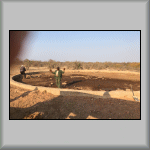 Photo BW-044 |
 Photo BW-045 |
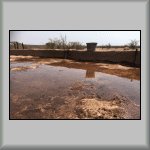 Photo BW-046 |
After just over two hours, the waterhole looked as can be seen in Photo BW-045. We weren't able to remove every gram of 'manure' in the allocated time, but after working for about three hours, the situation looked a lot cleaner than when we started; Photo BW-046. With the water pump having been restarted. Jo said that it would take 2 to 3 days to fill, providing there was enough water in the borehole.
For the afternoon's project, (the crocodile census), Dicks drove us to the Limpopo River, where we saw 13 crocodiles, one of which was a big fellow (about 4 metres in length)!
After returning to the Motswiri camp, the sound of two roaring lions
could be heard - and not far away! They were also heard throughout the
night!
Friday, 16-Sep-2016
Today's two projects: Wire Removal and a Bird Census.
Before starting the wire removal activity, we visited the waterhole that we cleaned yesterday (Photo BW-046), to check the overnight water level. Unfortunately, the water pump wasn't working, probably because the water level in the borehole had dropped. Additionally, elephants had been at the waterhole and deposited lots of fresh 'manure'!
Then it was off to collect more fence wire. We started at GPS: S22 19' 56.00" E28 50' 35.20" and finished further along the cut line, at GPS: S22 26' 4.00" E28 50' 41.60" (Photo BW-047).
After 'the wire removal troupe' had had lunch, Dicks and Esteban returned from their shopping trip to Bobonong. One of the shopping bags had been 'attacked' (in the truck) by some thick black oil. While helping to unload the groceries, guess who's shorts happen to brush against that particular bag! I soaked the shorts overnight, in detergent.
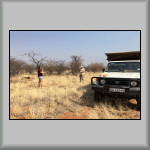 Photo BW-047 |
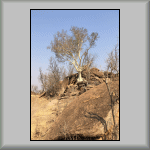 Photo BW-048 |
At 14:30, we set off to do a bird census. En route, we passed a Rock Fig Tree (Photo BW-048); quite an incredible sight, with its white trunk and white roots that disappeared into the rock crevices!
Back to the birds, and in chronological order (view in Google Earth), we saw the following species:
Note: As with last week's bird census, the links have been taken from Wikipedia's List of Birds of South Africa.
We arrived back at camp at 18:00. On the whiteboard (for 18:00), someone had written Surprise. Fortunately, we were permitted to have a shower, because our evening dinner was to be around a camp fire; but not the Motswire camp fire. With two trucks loaded, we drove a few hundred metres away and set up a table and chairs near the two waterholes. Dinner was a Fruit Curry with Rice; excellent! Although we had torches, they weren't really needed, as the moon was full.
We hadn't finished eating when a lonely elephant circled us, then went to the smaller of the two waterholes. It must have detected our presence, as it started walking towards us! We made a quiet, but hasty retreat to one of the Land Cruisers; it was quite a tense moment! It then turned to its left (our right) and disappeared into the bush. Phew! That was close!
We returned to our seats and finished our meals, listening to zebras and elephants in the darkness.
Blow me down, about 20 minutes later, a herd of elephants appeared out of the bush, to our left, and congregated around the same waterhole! Again, we quietly retreated to the safety of the Land Cruiser. Caroline, Esteban and I were wearing white T-shirts! That was a mistake, as they were quite visible in the moonlight! Five of us were either on or beside the vehicle. With the previous encounter fresh in our minds, I, on the other hand, made sure that the complete vehicle was between me and the elephants! I positioned myself at the front of the vehicle, while the elephants were some distance away from the rear of the vehicle!
Two of the elephants started walking towards us, but again, turned to their left and led the herd into the bush, and on to the next waterhole!
Once we had settled down again, Jens performed a fire 'dance' in front of the fire. We finally packed up and returned to the camp at about 22:00. What an eventful evening!

Jens' Fire Dance
[1 minute, 35 seconds]
Being Saturday, there was no need to get up at 06:20. Instead, I awoke at 07:20. After breakfast, I washed my shorts and managed to remove the oil stain! Later that morning, we went and inspected a few waterholes, as well as a sealed pipe above a test bore hole. On our way back to the camp, Jens diverted the water flow (at the nearby wind pump), from last night's small waterhole, to the larger waterhole in front of the hide (GPS: S22 18' 03.40" E28 52' 04.10"), in anticipation of having some animal activity during tonight's sleep-over at the hide!
Back at the camp, I made a video tour (on foot) of the Motswiri Camp Site; see the following video clips: the full tour (available via YouTube (due to its size)), or the same video clip, but divided into two shorter clips.
 Motswiri Camp Site (Full) [4 minutes, 47 seconds] |
 Motswiri Camp Site (Part I) [2 minutes, 57 seconds] |
 Motswiri Camp Site (Part II) [1 minute, 55 seconds] |
When the time had almost come to depart for the sleep-over, Sophie and I took a couple of matresses and some food waste to the hide - while it was still light. As we approached the hide, Sophie spotted a few giraffes. We just sat very quiet and watched them (8 in total)! Unfortunately, I didn't have my iPhone with me (it was being charged) so I was unable to take any photographs.
It was dark by the time we returned to the camp. Five of us (Jens and us four volunteers) then made our way (back) to the hide; Sophie didn't accompany us as she had an early start tomorrow for Bobonong shopping.
A small herd of elephants arrived at the waterhole. One of them started going through the pile of food waste; yuk! A while later, a solitary bushpig arrived at the food waste, followed shortly by another seven.
We heard thunder and saw lightning in the distance and the wind was blowing strong (at times). It was a cold night, even though the night minimum temperature was 16°C; which is a mild night by U.K. standards! My sleeping bag certainly helped against the wind, but I still felt very cold!
| Previous (Week 1) |
 |
Next (Week 3) |
Click to reveal a Home Page QR Symbol
![]()